|
RANGE REPORT: DOUBLE TAP 10MM AMMO
Background.
On GlockTalk's 10Ring, Mike McNett is well-known to fans of the 10mm Auto. He's a reloading sage who, for many years, has
generously shared his load data on this great cartridge. For those new to reloading, Mike is a friendly source of advice and
more than willing to share his experiences. He now moderates GT's 10mm Reloading Forum, a place where 10mm shooters can exchange
information about their pet loads.
This year, Mike finally started his own ammunition company, Double Tap Ammunition (DT), which specializes in several flavors
of 10mm all having one thing in common: they're loaded very hot. While all the loads are within SAAMI pressures for
the cartridge, DT's line-up is 10mm Auto at full-throttle. Indeed, DT safely exceeds the velocities and energy specs
of Norma's original 10mm loads, which, historically, established the ballistic standards against which subsequent loads in
this caliber are assessed. DT currently offers six different loads using bullet-weights of 135gns, 165gns, 180gns, 200gns
and 220gns. (There are two 200gn loads, an XTP-HP and a FMJ-FP). Except for the 220gn FP and the 200gn XTP-HP, the other loads
all produce muzzle energies above 700 foot-pounds - and even then the FP and XTP are knocking on the door at 680 fpe
and 694 fpe, respectively. Moreover, the variety of bullet weights and types means that a particular load can be chosen for
a specific application, although some can serve multiple roles. The 10mm/.40cal bullets that DT uses are among the best of
currently available technology. Not just the Noslers or Golden Sabers, but the Hornady XTPs and FMJs too.
See: http://www.doubletapammo.com/main_site/index.html
Ammo ordered.
For this Report, I ordered a quantity of DTs "untouchable" defensive ammo topped with Remington's 165gn and 180gn Golden Sabers
(GS). (The 135gn Nosler HP load was not yet available). I was particularly interested in the accuracy and recoil characteristics
of the 165gn GS load. This load, at 1425fps, is only 5 grains lighter than Norma's original 170gn 10mm HP at 1400fps, designed
for the Bren Ten. Norma, at Dornaus & Dixon's request, later reduced the velocity to 1300fps. Nonetheless, in the mid-1980s,
this 170gn load was touted as the prototype for police use on the street.
Golden Saber Hollow-Points.
In terms of bullet technology, Remington's GSHP is light years ahead of Norma's hard-edged, nonexpanding hollow-point. And
that's of critical importance where the velocities involved meet or exceed original 10mm specs. Big Green describes its brass
jacketed HPs as "high performance," and specifically markets them for "law enforcement, home security and personal defense
applications." (Source: all quotes from Remington's 2003 catalog, p. 49). Remington asserts that its Golden
Saber HP combines "four critical elements of handgun bullet performance: match-type accuracy, deep penetration, maximum expansion
and virtually 100% weight retention." That's quite a statement, so I was looking forward to testing the GSs for accuracy and
expansion when propelled at real 10mm speeds. The jacket is designed to "expand to a larger diameter than the lead
core - over 1.6x caliber diameter," while the "minimal lead deformation retains energy for deeper penetration." The apparent
purpose behind the brass jacket is to control mushrooming, thereby "releas[ing] energy over [a] longer distance." In other
words: delayed expansion reduces deceleration of the HP in the body long enough to enhance the probability it will continue
far enough to strike vital organs, as opposed to "explosive" mushrooming with little penetration. The GS bullet has angled
"nose cuts" or grooves that go "completely through the jacket for better mushroom initiation over [the] widest range of practical
velocities." Okay, what are "practical" velocities? Remington doesn't say, but in its 40S&W the 165gn GS is loaded to 1150fps
and the 180gn GS to 1015fps. In contrast, DT's 165gn 10mm load is 275fps faster, while its 180gn load is 315fps
faster.
Guns used.
From the 4.6" barrel of a Glock 20, DT specifies that velocity of the 180gn GSHP is 1330fps/707fpe, while the 165gn GSHP is
1425fps/744fpe. McNett has further stated that from a 5" barrel you should expect a gain of 25-30fps over the "boxflap" velocity.
Thats good to know, because for this Report I used three common 10mm pistols, two of which have 5" barrels: a S&W 1006 and
a customized Delta Elite. The third was my G20. The particulars on each of these pistols (with photos) are provided elsewhere
on this site's "Collection" page. How DT's loads would perform from a 5" tube really interested me because that was the original
length for which Norma's high-power 10mm was intended.
Test Procedure.
A total of 450rds were fired during range testing with three 10mm pistols. The 450rds breakdown as: 150rds fired through each
gun (i.e., 75rds of each load through each gun). I tested for (1) reliability, (2) accuracy at distance and close in, (3)
felt-recoil, and (4) penetration. The penetration tests are described separately below. Trust me when I say that with full-strength
10mm ammo, you dont have to fire that many rounds before you see how your gun performs. Be advised that if anything
on it is weak, loose, out-of-spec, poorly installed or just plain defective, a hot 10mm load will bring that fact to your
attention immediately. This includes sights, screws, pins, safeties, slide-stops, extractors and springs of all kinds, including
those in your mags. A 10mm pistol that runs without a hitch firing Blazers' 200gn FMJ @ 1050fps can suddenly start hiccupping
when the same bullet goes 200fps faster. Again, as the feet-per-second increase, anything "iffy" on your gun will be made
known to you.
Reliability.
There were no malfunctions of any kind with the Smith 1006. I switched between 20lb & 22lb Wolff recoil springs with each
DT load, and functioning was flawless. I'm sure the Wolff XP springs in the mags also helped, but this gun has yet to jam
or fail to extract or eject with any type of hot 10mm load, including DT's.
With the Tibbets-customized Delta Elite, functioning was near perfect. The sole exception was a "stovepipe" jam that happened
after firing about 50rds. At the time, I was using a 9-rd CMC mag with the 180gn load, and I'm still pretty sure it was a
magazine problem, not an ammo problem. I had with me at the range some 8-rd Colt factory mags and other CMC mags. After
noting the incident in my log, I put aside the suspect mag and continued shooting. No problems occurred with other mags, and
there were no failures to feed, fire, extract or eject.
In the range bag with the G20, I brought along a "pre-ban" 15rd mag and a "post-ban" 10rd mag. I have several 10rd mags and
use them for "practice" mags. When shooting DT loads from the 15rd mag, the gun ran smoothly. The G20 is stock, except for
an ISMI captive 22lb spring and tritium night sights. With the 10rd mag, I had shot about 5 or 6 rds of the 165gn load when
the slide-stop lever suddenly started engaging each time the gun fired. I removed the 10rd mag and loaded it full again, inserted
it, released the slide and fired. Instant slide lockback. I released the slide again and it chambered the next round. I fired
it, and the slide locked back again. I removed the 10rd mag, inserted the loaded 15rd mag, released the slide and fired. No
problems whatsoever. The G20 shot and cycled all 15rds without a hitch until the slide locked back on the empty mag, like
it should. That doesn't seem like an ammo issue, and I'm certain my finger wasn't hitting the slide-lever. It's probably not
a weak spring under the lever either, but rather a weak spring in the 10rd mag. None of these mags ever gave me this problem
before. I've ordered some Wolff XP mag springs, so we'll see if that cures it.
Accuracy.
The accuracy of DT's defensive ammo was impressive. The photos below show the typical accuracy from my guns. Testing took
place at an outdoor range, and all shooting was done off-hand. No rests were used.
I tried two types of shooting with each load. First, close range or "combat distance" shooting was done from 5 yards. The
idea was to assess controllability during rapid-fire through a full magazine. Starting from a two-hand "low ready" position,
Weaver-type stance, I raised the pistol and fired as fast as I could get the front sight back on target - sort of a "front
sight, press - front sight, press" technique. On some targets I tried double-tapping, but switching among three pistols gave
mixed results. Ideally, you practice with one pistol until double-tapping becomes second nature with that gun and that
load. While the G20 and the S&W 1006 were probably tied for best rapid-fire accuracy, there were really no "bad" targets.
I avoided firing wildly for pure speed. It might be marginally faster, like "point shooting," but it doesn't get you very
far. In the real world and in law enforcement, you're going to have to account for every shot fired, and you can't get the
bullet back once it leaves the barrel. Still, the rapid-fire controllability of DT's defensive loads was manageable.
Distance shooting was done slow-fire, using a two-hand hold, with attention paid to sight picture, breath-control and correct
trigger manipulation. The G20 and the S&W 1006 were shot from the 50-foot line. Because the Delta has a hand-fitted Bar-Sto
barrel, I shot it from 60-feet (20 yards). Generally speaking, groups of 2"-2.5" were the norm for the G20 and S&W 1006. The
Delta turned in several 1.5" and a few 2" groups, excluding flyers. As a final test, I took the Delta back to 25 yards, where
I fired 18-shots of the165gn GSs at a 5" Shoot-N-C bullseye. (Flyers were my fault and are circled in the photos below).
While the shooter is always part of the equation, the accuracy of DT's Golden Saber loads was excellent. This is quality ammunition
and there is definitely shot-to-shot consistency.
Felt recoil.
Maybe it's the special powder McNett uses, but given the claimed velocities, recoil wasn't bad at all. That said, each gun
exhibited different recoil characteristics. The recoil of DT's loads really only matters where speed is an issue, and even
then frequent practice increases your ability to handle it. Still, there's the platform to consider. Of the three guns used,
recoil in the S&W 1006 was a nonissue. This gun is an all-steel tank, and between its recoil-dampening weight and the Hogue
rubber grips, it was sheer fun shooting both loads.
About the same can be said for the G20. With full-strength loads, you begin to understand how the Glock's heavy steel slide,
flexing polymer frame, wide grip and low bore-grip axis all work together to absorb and spread recoil.
The Delta normally uses a 22lb Wolff variable recoil spring, but for this test I installed a 24lb spring. Recoil with the
180gn load, while "felt" more than in the others, wasn't bad at all, being more of a stout straight-back push. Though all
steel too, the Delta is lighter than the 1006 and has a narrower grip. But Vic Tibbets' work on the ergonomics, like the front-strap
checkering and high-sweep BT grip safety, allowed for greater control with less perceived "snap" than on a stock gun.
Penetration. These tests were certainly not definitive, and as time permits I'd like to do more with both loads.
Test #1: Phone books & denim. For this test I used my Delta with the 165gn GS. Two medium-sized phonebooks were
soaked in water overnight. They were duct-taped around the edges only enough to keep them together. Water-swollen, they measured
just under 8.5" through the center. At the range, I placed the phonebooks inside some little-worn denim shorts, which added
about half an inch to the total thickness, and then set the whole thing up on a stand. For point of aim, I marked a spot
on the denim where the bullet would have to traverse the full thickness of the books, and then went back 30 feet (10 yards).
I fired one shot, which hit about where I'd marked. The books moved a bit, but not much and there was a small entrance hole
in the denim. Cutting off the duct tape, I found a lot of shreaded paper with a progressively larger hole through it, leading
out the other side. At first I couldn't find an exit hole in the denim. Then I saw there was none, because the GS had come
to rest neatly in the left front pocket of the shorts. The recovered slug showed full, textbook expansion. The exposed lead
was flattened, and the petals were peeled all the way back and around the off-side. Retained weight was 166 grains,
which obviously included denim and paper debris trapped in the petals. (See photos below). According to my calipers, the diameter
of the flattened lead is 0.659. This is consistent with Remington's claim that expansion should be "1.6x caliber diameter"
(i.e., 1.6 x .400 = .640).
Test #2: Beef & denim. For this test, my Smith 1006 and the 180gn GS were used. I purchased several types of
meat: a 1" thick t-bone steak and several slices of boneless beef of varying thicknesses and grizzle-content. I put the t-bone
steak in the middle of the other beef slabs, so they more or less formed one pile or "brick" of meat. I then wrapped this
"brick" in a single layer of thin plastic wrap. I placed the wrapped meat, now just over 5.5" thick, inside a large ziplock
bag. I filled the bag about 2/3rds of the way with water, let the air out and closed it up. The total thickness of the bag
with the beef & water was now about 7.5"-8." The idea here was to approximate not only human muscle and sinew, but also the
layers of membrane and fluids that make up vital organs and surrounding areas. I then put the bag inside some old denim jeans,
as before, to add the element of an intermediate barrier of clothing. I went back to 30 feet and fired a single shot, the
point of aim being the center of the thickest part of the denim/meat/water unit. The 180gn GS penetrated directly through
the denim into the meat, causing the water to drain out and soak the jeans. The bullet broke off a piece of steak bone, and
fragments of bone and denim material were carried into the "wound path." However, the bullet exited the opposite side and
could not be recovered. (See photos below). Thus, the expansion issue is inconclusive. A closer look revealed a large hole
through the rear of the "brick" where the meat was violently disrupted - damage with a capital "D." The GS must have
expanded some before exiting, but just how much is unknown. I found no evidence of bullet disintegration.
Conclusions.
Mike McNett has done well. Double Tap's 10mm loads were quite accurate and their power level is reasonably controllable for
those who are serious about using the 10mm Auto. While a few companies load this cartridge at or near its original specs,
Double Tap offers what is arguably the best and widest line-up of "high-power" 10mm available in the United States today.
I also think McNett hit a home run in choosing the Golden Sabers for these velocities. Against denim and wet phone books the
165gn GS did what it was designed to do. At this energy level, it is probably the perfect "all seasons" defensive load. For
those living in hot-weather states, thin-walled apartments or dense urban centers, you might try DT's new 135gn Nosler HP
load. In rural areas or in cold weather regions, where an assailant would likely wear bulky winter gear, thick leather or
layered clothing beneath a heavy outer coat, and anywhere else penetration is a priority, the 180gn GS is probably a better
choice. Among premium self-defense ammo in 10mm, this load defines "heavy & fast."
Hopefully, DT will add to its 10mm line-up an economical "practice" load that approximates the velocities of its GSs.
A final word to the wise: unlike other calibers out there, the 10mm Auto at full-power can be a harsh mistress
for the "once-a-month-warrior." Hand-eye coordination and muscle memory develop over time. They are perishable and will fade
quickly without repeated range sessions. If you intend to carry such loads for duty or CCW, then you need to practice regularly
to achieve - and maintain - proficiency and good shooting technique.
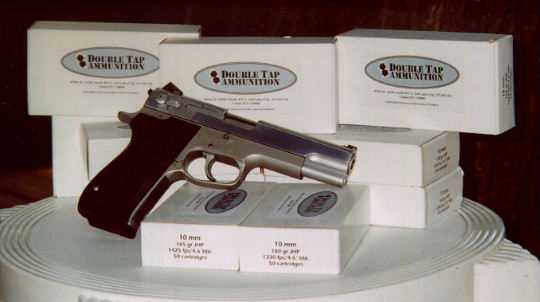
PIC #1
|
| S&W 1006, with Double Tap's 165gn & 180gn Golden Saber loads. |
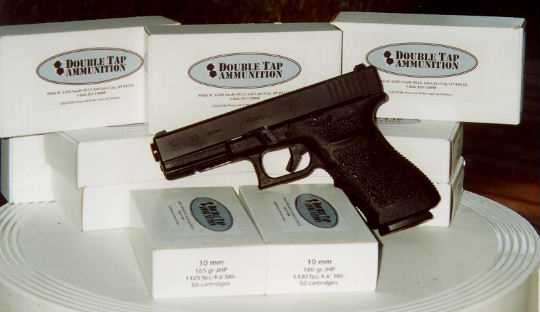
PIC #2
|
| Glock 20 & DT ammo. |
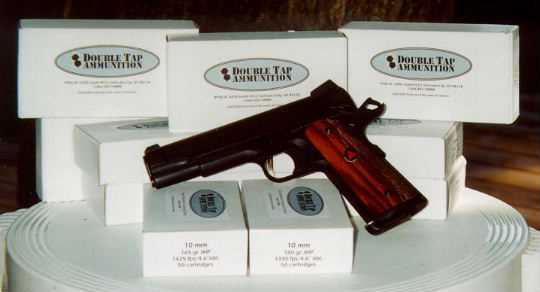
PIC #3
|
| Delta Elite, customized by Vic Tibbets, and DT ammo. |
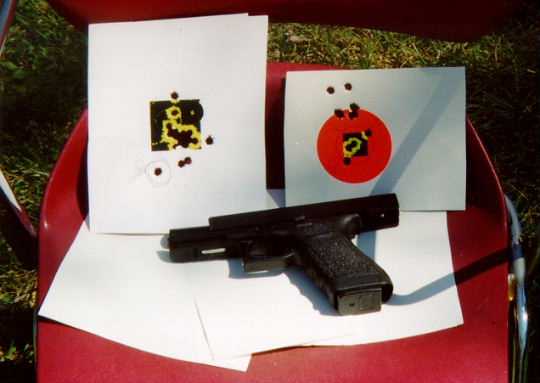
PIC #4
|
Glock 20 & 165gn GS load.
Left target is 15-shot, 2.5" group (excluding flyer) from 50-feet. Right target shows 10-shot rapid fire group from 5 yards
(with some bullets going through same holes). Shooting on all targets was done off-hand. |
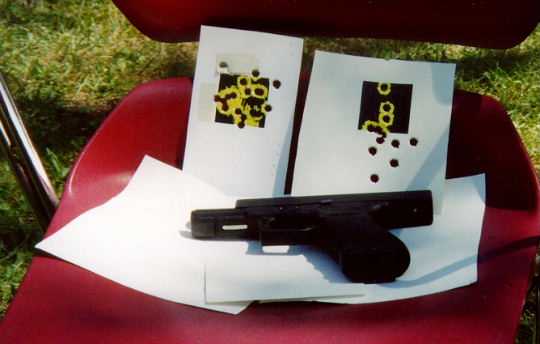
PIC #5
|
Glock 20 & 180gn GS load.
Left target is 15-shot, 2.5"
group from 50-feet, with 1.75" cluster in the black. Right target shows 12-shots rapid-fire from 5 yards. The G20 seemed
to prefer the 180gn GSs. |
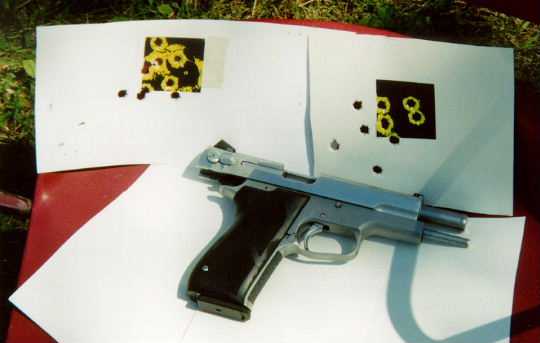
PIC #6
|
S&W 1006 & 180gn GS load.
Left target is 10-shot, 2.25"
group from 50-feet. Right target is 10-shot rapid-fire group from 5 yards. |
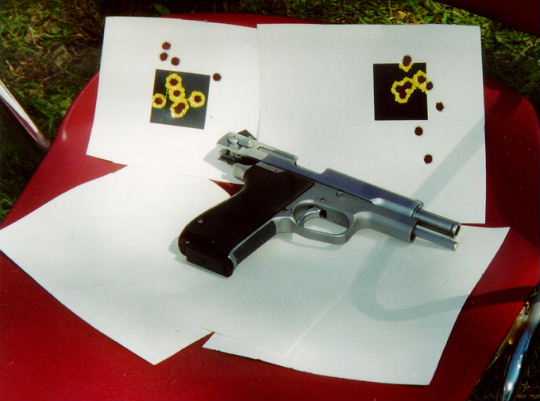
PIC #7
|
S&W 1006 & 165gn GS load.
Left target is 10-shot, 2.25"
group from 50-feet, but 6 shots in the black measure 1.4". Right Target is 10-shot rapid-fire group. The 1006 preferred
the 165gn GSs. |
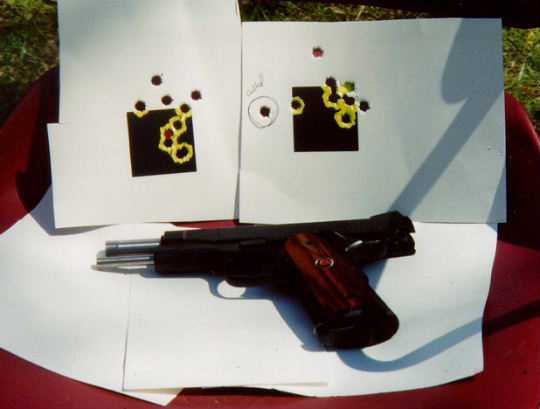
PIC #8
|
Tibbets Delta Elite & 180gn GS load.
Right target is 9-shot,
2.25" group fired from 60 feet (20yds). Excluding flyers, remaining 7-shots in black measure 1.75". Left target shows rapid-fire
group from 5 yards. |
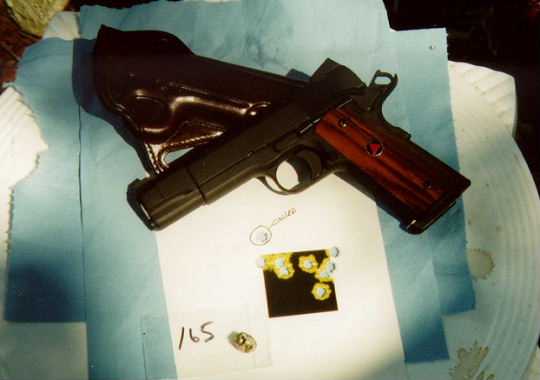
PIC #9
|
Delta Elite & 165gn GS load.
Target shows 9-shot group
fired from 60 feet. Excluding flyer, remaining 8-shots measure 2.1". Shown with Galco's "Concealable" 1911 holster and 165gn
GS slug recovered from test using phonebooks and denim. |
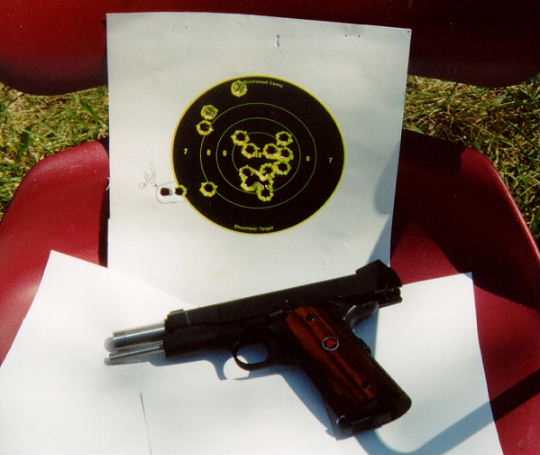
PIC #10
|
DE & 165gn GS load from 25 yards.
Target is a 5" "Shoot-N-C"
bullseyes. Using two 9-rd CMC mags, 18-shots were fired consecutively, off-hand. Despite the flyers, the 12-shot cluster
around the 10 Ring measures 2.1". The DE really liked the 165gn GSs. |
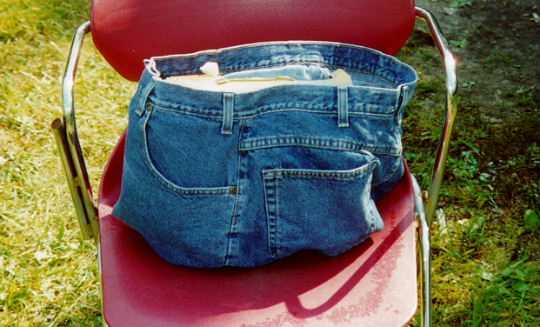
PIC #11
|
Penetration test #1:
165gn Golden Saber against phone books
& denim. Photo shows two water-soaked phone books inside jeans. |
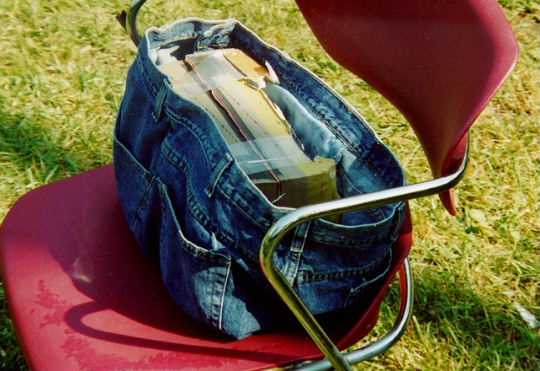
PIC #12
|
| Closer view of phone books inside denim jeans. |
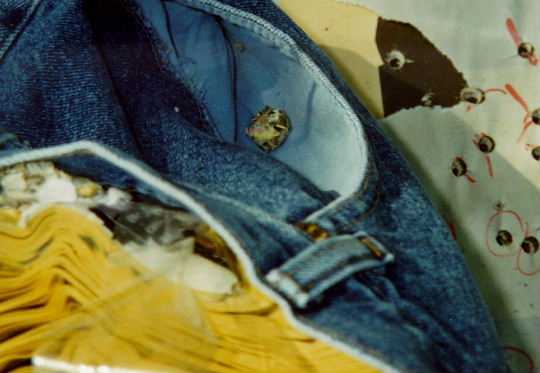
PIC #13
|
| Taken after shot, this photo shows 165gn Golden Saber slug found
resting inside front pocket of jeans. Note how innards of phone book are shredded. Recovered slug weighed 166gns, which includes
particles of denim & paper debris. |
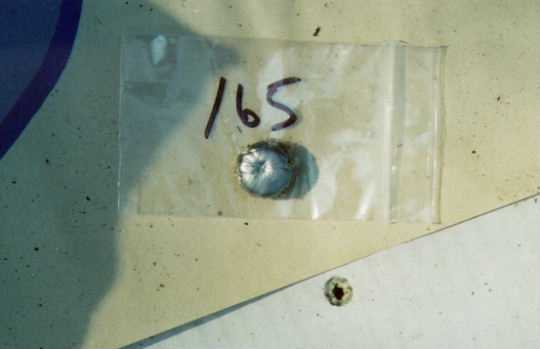
PIC #14
|
| Another view of 165gn slug. Lead is flattened out and petals are
peeled back perfectly. Diameter was 0.659. This is consistent with Remington's claim that Golden Saber will expand to at least
"1.6x caliber diameter" (i.e., 1.6x .400 = 0.640). |
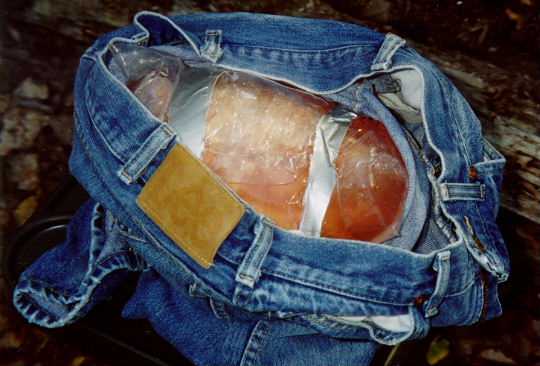
PIC #15
|
Penetration test #2:
180gn Golden Saber against beef &
denim. Photo shows top view of "brick" of meat, surrounded by water and loosely taped, inside jeans before shot. |
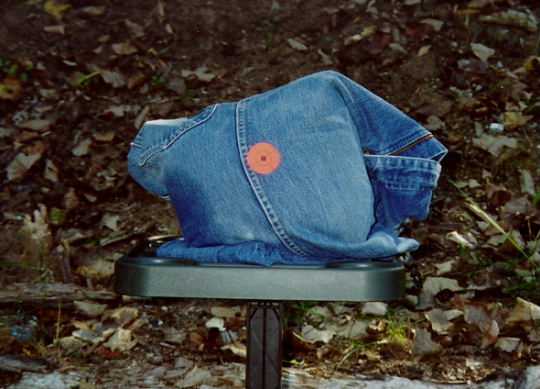
PIC #16
|
| Small orange target on jeans shows point of aim along seam line. |
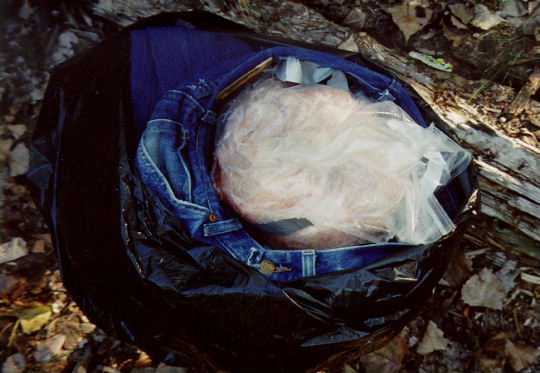
PIC #17
|
| Photo taken immediately after shot. Water drained out, soaking jeans.
180gn slug penetrated through denim and meat, broke off piece of steak bone, and exited opposite side. Bullet couldn't be
recovered. |
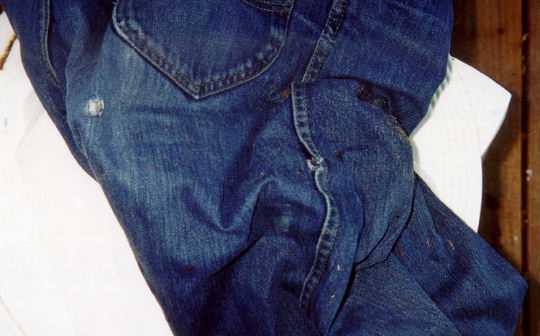
PIC #18
|
| Photo shows entry hole on seam of jeans (center right), with larger
exit hole on offside (upper left). |
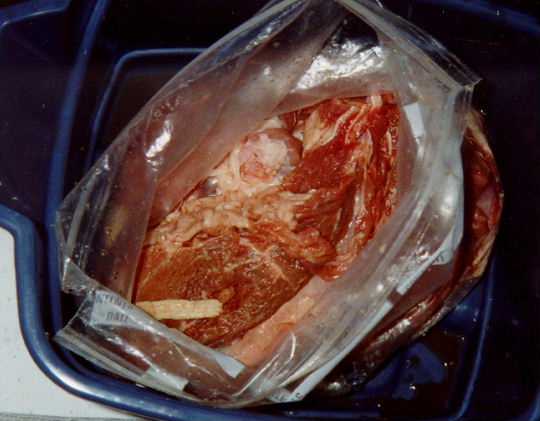
PIC #19
|
| Meat "tissue" was violently disrupted by 180gn Golden Saber, with
larger cavity toward rear of meat. Fragments of bone and denim were carried into "wound path." |
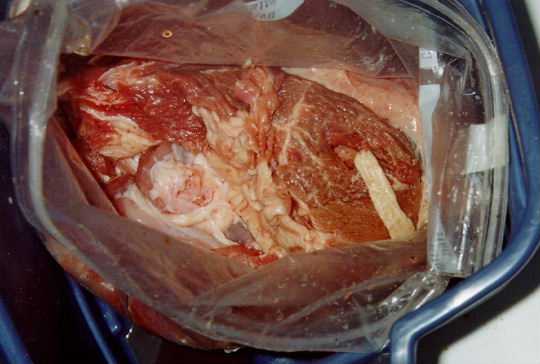
PIC #20
|
| Closer view of disruption to meat caused by 180gn GS near exit area.
Big time damage. |
|

